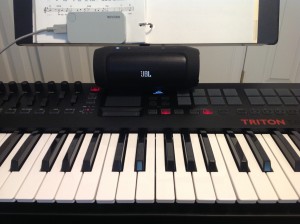Sometimes the best inexpensive multi-effect stomp box is pitched as a vocal harmony processor.
The built-in effects on the Korg Triton Taktile (TT) are rather plain and unpronounced. So, I cast the net for stomp boxes to beef up the keyboard sounds with reverb, chorus, phaser, flanger, tremolo and the rest of the usual suspects. Something to spice up the guitar sounds is also nice. Vocal harmony processing never entered my mind since I rarely sing.
My first thought was to build a small pedal board of stomp boxes. Based on Internet reviews, I bought a TC-Electronic Hall of Fame (HOF) Reverb pedal. It’s stereo, clean and the preset algorithms are terrific. I love this little red box! Its Toneprint capability is really a gas. Through Toneprint, you can actually add chorus or flanger, making it a good, small, one pedal solution for keyboard effects. I also use the HOF for recording — the algorithms and cleanliness are that good.
Based on that success, my next thought was to add more TC-Electric pedals. TC’s guitar pedals hit the street in the $100 to $150 (USD) range. Thus, you can run up a bill pretty fast covering all of the bases!
Enter the TC-Helicon Play Electric (PE). After finding a very attractive price for the PE at ProAudioStar, I investigated its capabilities. Thanks to smart signal routing, the PE is really like two multi-effect processors in one — one side is a guitar chain and the other side is vocal harmony and effects processing. I’m going to concentrate on the guitar side here as I haven’t explored the vocal harmony processing yet.
The guitar effects chain consists of amp simulation, compression, modulation, delay and reverb. It covers all of the major effect food groups except phaser. What it does cover, it does very well. There are a small number of “greatest hit” algorithms from the Corona Chorus, Vortex Flanger and the HOF — all very usable. The user interface is a breeze and I quickly pulled together presets for chorus, flange, rotor, pan, tremolo and auto filter. The Triton Taktile electric pianos sound great through the PE effects. Thanks to the factory presets, U2 can sound like The Edge (pun intended). The rather lame electric guitars sound huge through the PE presets.
The quality of the rotor effect is a real surpise. Although the Neo Instruments Ventilator doesn’t have anything to fear, the rotor is not bad and it compensates for the TT’s inability to switch between slow and fast rotor speed. (If you can stand the sometimes maddening swirl of rotor-on-rotor violence.) I programmed slow and fast rotor presets in adjacent locations and can switch between fast and slow via the increment and decrement switches on the pedal.
What does the Play Electric give up in favor of lower cost? The individual pedal approach has the advantage of immediacy — lots of knobs and switches to play with. The PE effects are easily tweaked through the UI, but lack the immediacy of front panel knobs. Further, the PE exposes only the most important parameters through the UI, emphasizing convenience over tweaking. The compressor parameters roll up the whole lot of attack, release, etc. into “Amount” and “Makeup” parameters. TC-Helicon offer deeper editing in the much more expensive (and heavier) Voice Live. The Voice Live also has a wider range of effects. From what I’ve heard so far, however, I’m good with the Play Electric.
I look forward to trying the vocal side. The PE does not have MIDI IN for scale detection — it’s all audio, baby. The PE has built-in microphones and will detect scale out of the sonic ether as well as processing the audio signal at the guitar input. I’ll post results after experimenting.
The TC-Helicon Play Electric is normally advertised in the live sound section of on-line and print catalogs. Thus, it’s worth checking out vocal processors when looking for keyboard/guitar effects. You might be surprised at what you’ll find.
There is one alternative to the PE that looks viable for keyboard players. Keyboardists don’t usually chain effects together like a guitar player and often one additional effect through a reverb will do. The Line 6 M5 pedal is the “Swiss Army Knife” of effects. It does one effect at a time and has a very wide range of available effects (much greater than the PE). The M5 has stereo inputs (while the PE is mono). An M5 coupled with the HOF would be a capable duo at a reasonable total cost.
Switching gears a little bit, I don’t know why Keyboard Magazine and other keyboard-oriented publications don’t review effect pedals very often. These pedals are just as vital and useful to keyboard players as they are to guitarists. The Keyboard Magazine guys need to drop by the Guitar Player offices while they are writing their massive annual pedal round-up.

